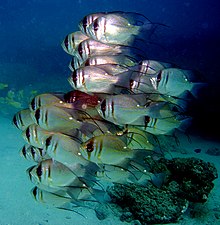Pempheriformes
| Pempheriformes | ||||||||||||
|---|---|---|---|---|---|---|---|---|---|---|---|---|

Pempheris mangula |
||||||||||||
| Systematics | ||||||||||||
|
||||||||||||
| Scientific name | ||||||||||||
| Pempheriformes | ||||||||||||
| Betancur-Rodriguez et al., 2013 |
The Pempheriformes or Acropomatiformes are a fish order from the group of perch relatives (Percomorphaceae).
The order was established in 2013 by the team of fish systematics specialist Ricardo Betancur-R. introduced, the taxa assigned to this taxon previously belonged to the order of perch-like (Perciformes). With the emergence of cladistics and the method of DNA comparison for kinship analysis, however, it became clear that the Perciformes are not a monophylum .
Already in 2007 presented Smith and Craig a relationship between the wreck bass (Polyprionidae), the long-finned pike ( Dinolestes lewini ), the tank heads (Pentacerotidae) and the lantern bellies (Acropomatidae) firmly. In February 2009, Blaise Li et al . Described in their analysis of the relationships between the various groups of Acanthomorpha a monophyletic clade composed of the Howellidae , the Lateolabracidae and the deep-sea cardinalfish (Epigonidae) .
In a revision of the bony fish systematics published in early 2013 by Ricardo Betancur-R. and colleagues, the Pempheriformes with a total of 14 families are introduced as the new order of perch relatives (Percomorphaceae). Two more families were added in October 2015 and four more in October 2018, so that the Pempheriformes order included a total of 20 fish families at the end of 2018. Sister group of the Pempheriformes are the Centrarchiformes .

features
The relationship of the families assigned to the Pempheriformes is based on molecular biological studies and is not yet supported by morphological features. All species of the Pempheriformes live in the sea, some also go into brackish water, none of them live in fresh water. Numerous types of Pempheriformes have the ability to produce bioluminescence . This ability arose four to five times independently of one another within the Pempheriformes.
Systematics
The Pempheriformes include over 300 species in 20 families worldwide.
- Acropomatidae , 12 species
- Banjosidae , 3 species
- Deep-sea herring (Bathyclupeidae), 10 species
- Crocodile toothfish (Champsodontidae), 13 species
- Sand cave fish (Creediidae), 18 species
- Langflossen Hecht (Dinolestidae), 1 type
- Deep sea cardinalfish (Epigonidae), 46 species
- Pearlfish (Glaucosomatidae), 4 species
- Hemerocoetidae , 26 species
- Howellidae , 8 species
- Lateolabracidae , 3 species
- Slim Himmelsgucker (Leptoscopidae), 5 species
- Malakichthyidae , 14 species
- Ostracoberycidae , 3 species
- Glass or hatchet fish (Pempheridae), 85 species
- Armored heads (Pentacerotidae), 14 species
- Wreck perch (Polyprionidae), 4 species
- Gnome fish (Scombropidae), 3 species
- Symphysanodontidae , 13 species
- Synagropidae , 17 species
The following cladogram shows the internal systematics of the Pempheriformes according to the latest phylogenetic studies:
| Pempheriformes |
|
||||||||||||||||||||||||||||||||||||||||||||||||||||||||||||||||||||||||||||||||||||||||||||||||||||||||||||||||||
|
|
Individual evidence
- ↑ a b c d Ricardo Betancur-R, Edward O. Wiley, Gloria Arratia, Arturo Acero, Nicolas Bailly, Masaki Miya, Guillaume Lecointre and Guillermo Ortí: Phylogenetic classification of bony fishes . BMC Evolutionary Biology, BMC series - July 2017, DOI: 10.1186 / s12862-017-0958-3
- ↑ a b c d e f g h i Ghedotti, MJ, Gruber, JN, Barton, RW, Davis, MP & Smith, WL (2018): Morphology and evolution of bioluminescent organs in the glowbellies (Percomorpha: Acropomatidae) with comments on the taxonomy and phylogeny of Acropomatiformes. Journal of Morphology, October 2018, doi: 10.1002 / jmor.20894
- ↑ Smith, L., Craig, M., 2007. Casting the percomorph net widely: the importance of broad taxonomic sampling in the search for the placement of serranid and percid fishes. Copeia (1), 35-55. doi : 10.1643 / 0045-8511 (2007) 7 [35: CTPNWT] 2.0.CO; 2
- ↑ Blaise Li, Agnès Dettaï, Corinne Cruaud, Arnaud Couloux, Martine Desoutter-Meniger, Guillaume Lecointre: RNF213, a new nuclear marker for acanthomorph phylogeny. Molecular Phylogenetics and Evolution, Volume 50, Issue 2, February 2009, Pages 345-363 doi: 10.1016 / j.ympev.2008.11.013
- ↑ a b c Millicent D. Sanciangco, Kent E. Carpenter & Ricardo Betancur-R. 2015. Phylogenetic placement of enigmatic percomorph families (Teleostei: Percomorphaceae). Molecular Phylogenetics and Evolution. October 2015, doi: 10.1016 / j.ympev.2015.10.006
- ↑ Stereolepis gigas on Fishbase.org (English)
- ↑ Acropomatiformes by Parenti
- ^ Thomas J. Near, A. Dornburg, RI Eytan, BP Keck, WL Smith, KL Kuhn, JA Moore, SA Price, FT Burbrink, M. Friedman & PC Wainwright. 2013. Phylogeny and tempo of diversification in the superradiation of spiny-rayed fishes. Proceedings of the National Academy of Sciences of the United States of America. 101: 12738-21743. doi: 10.1073 / pnas.1304661110 , PDF
- ↑ Kenji Odani & Hisashi Imamura: New Phylogenetic Proposal for the Family Leptoscopidae (Perciformes: Trachinoidei). Bull. Fish. Sci. Hokkaido Univ. 61 (2/3), 49-63, 2011. PDF





